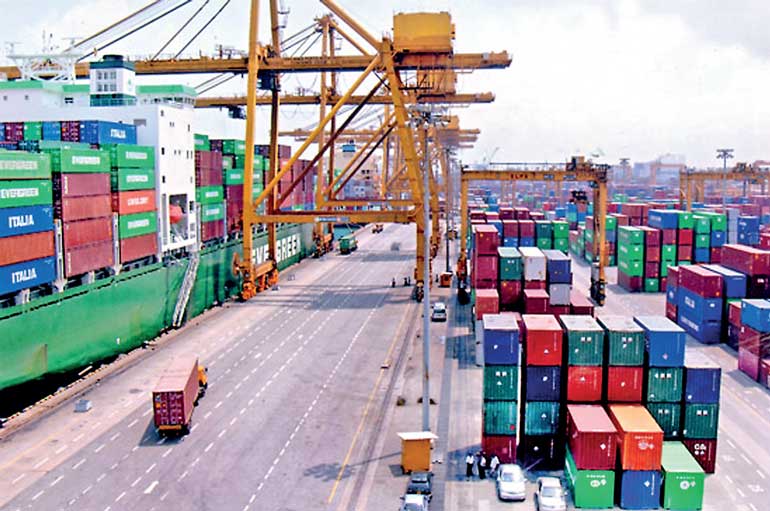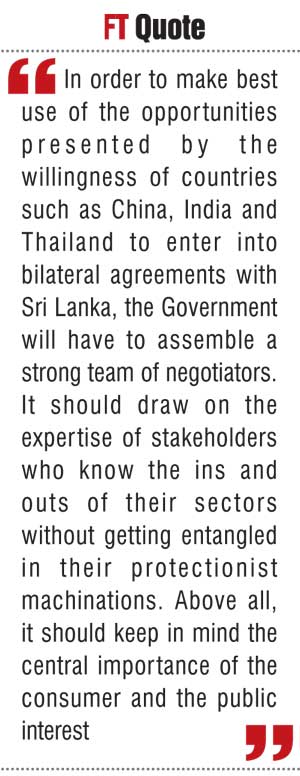Thursday Dec 11, 2025
Thursday Dec 11, 2025
Wednesday, 16 March 2016 00:00 - - {{hitsCtrl.values.hits}}

The challenge and the opportunities
Sri Lanka’s exports have declined as a proportion of GDP. Young people lacking high-quality jobs in manufacturing and services demand easy Government jobs or leave the country.
Such jobs are not being created partly because, six years after the end of the war, foreign investments in tradeable sectors have not picked up as expected. Unless there is a significant increase in investment and improvements in productivity, Sri Lanka will have difficulty in succeeding in export markets.
Competitor countries like Vietnam are entering into multiple trade agreements that will result in further erosion of export markets.
It is in this context that the Prime Minister asked for, and received, a mandate at the General Election in August 2015 to conclude  trade agreements with our major trading partners. This is an opportunity, not a threat as portrayed by uninformed opponents.
trade agreements with our major trading partners. This is an opportunity, not a threat as portrayed by uninformed opponents.
Misrepresentations
Trade agreements are not mechanisms for ensuring that exports of one party can be increased and trade surpluses ensured. They are supposed to benefit both (or all, in the case of multilateral agreements) parties by reducing uncertainty and transaction costs.
Bilateral agreements like the India-Sri Lanka Free Trade Agreement (ISLFTA) of 1998 are theoretically inferior to multilateral agreements such as the agreements on liberalising trade in goods (GATT) and services (GATS) that Sri Lanka has been party to for many years. However, the Doha Round that was intended to advance those multilateral agreements is stalled.
Sri Lanka’s only options at this time are bilateral agreements. While theoretically sub-optimal, they can be flexible. For example, Sri Lanka succeeded in keeping a large number of sectors in the negative list of the ISLFTA, including the entire auto sector, including two-wheelers, three-wheelers and four-wheeled vehicles. Thus Sri Lanka is free to impose high duties on these imports as it wishes. And it does. These revenue-raising measures are not prohibited because they are outside 
the ISLFTA.
Yet, the Indian vehicles have succeeded in displacing the more expensive Japanese imports. Even with the high duties, they are more affordable for ordinary consumers who do not have vehicle permits, such as those extorted from the Government by the GMOA.
It is illogical, as many opponents of trade agreements do, to claim that there is something wrong with increased Indian imports, mostly occurring outside the ISLFTA. There is nothing wrong with cheaper Indian vehicles displacing Japanese imports. Even if the trade deficit with India increases, that with Japan has decreased. In any case, none of these things can be blamed on a trade agreement that has expressly excluded automobile imports.
In goods-trade agreements, only sectors that are explicitly placed on a negative lists are excluded. In services-trade agreements, it is the opposite. The sectors that are not explicitly included in a positive list are outside the scope. This allows for negotiating governments to carefully calibrate their market-opening actions.
Even when a sector is opened up, it is not all or nothing. The detailed schedules that are integral elements of services-trade agreements permit even finer calibration. For example, it is possible, as the government has stated, to open up service sectors without liberalising Mode 4 trade (which permits some kinds of trade-related movements of persons across borders). Exemptions to the national treatment principle (a core element of international trade law that requires foreign suppliers to be treated the same as domestic suppliers) are permitted as long as they are set out in the schedules.
Instead of taking the trouble to learn about the actual modalities of entering into services-trade agreements, some opponents make sweeping generalisations about across-the-board market opening and even about immigration laws being abolished. Or is that they do not want to learn, preferring misrepresentation? It is said that it is impossible to wake those who are pretending to sleep.
How to best use the opportunities
There is no doubt services-trade agreements are flexible and complex. The flexibility afforded by the modalities of modern trade agreements that almost always include services chapters was presented above as a good thing. But skills are required to make optimal use of flexibility.
Our partners and competitors have been busily negotiating trade agreements over the past decade and have, in the process, gained considerable expertise in negotiating and drafting.
Sri Lanka was early in negotiating modern trade agreements but we lost the early-mover advantage. If not for the early dissolution of Parliament in 2004, Sri Lanka would have been the second country after Singapore to enter into a comprehensive bilateral agreement with India. Over the past 12 years, much has happened in international trade negotiations.
In order to make best use of the opportunities presented by the willingness of countries such as China, India and Thailand to enter into bilateral agreements with Sri Lanka, the Government will have to assemble a strong team of negotiators. It should draw on the expertise of stakeholders, who know the ins and outs of their sectors without getting entangled in their protectionist machinations. Above all it should keep in mind the central importance of the consumer and the public interest.